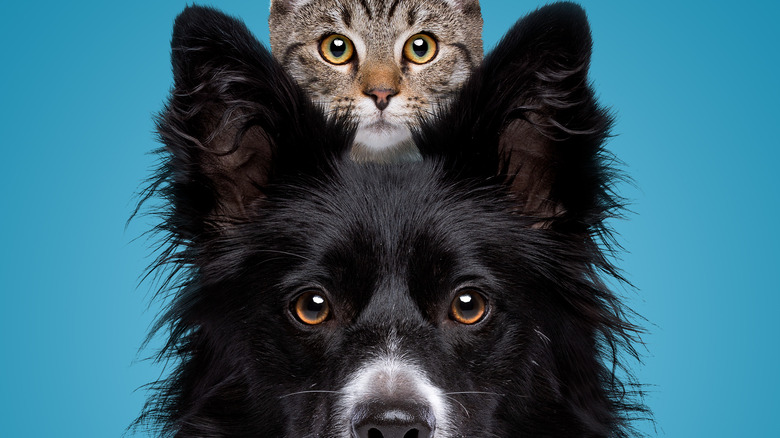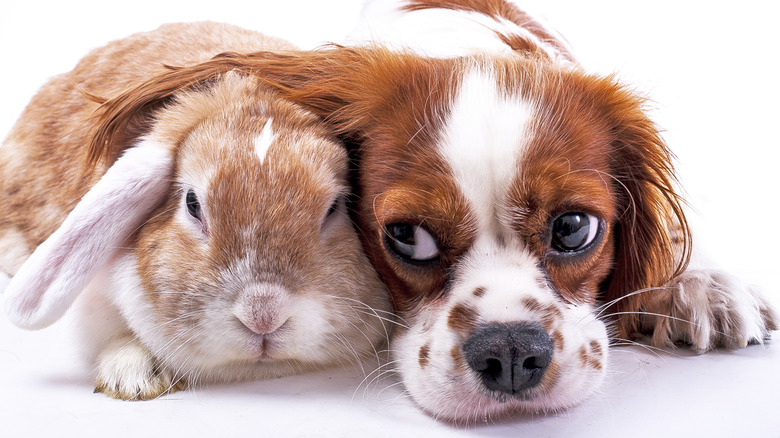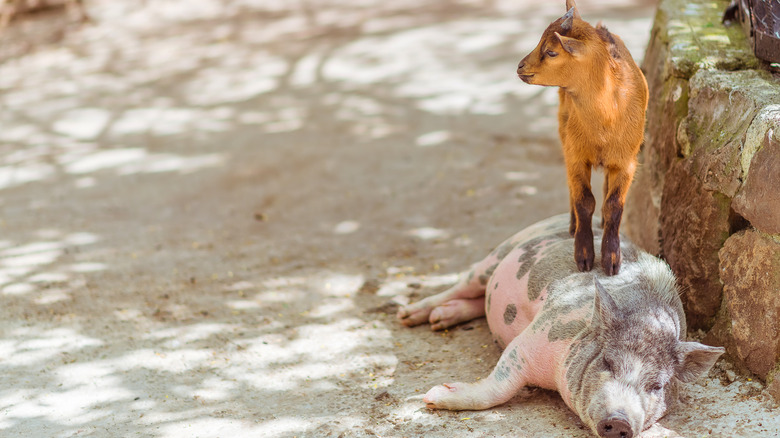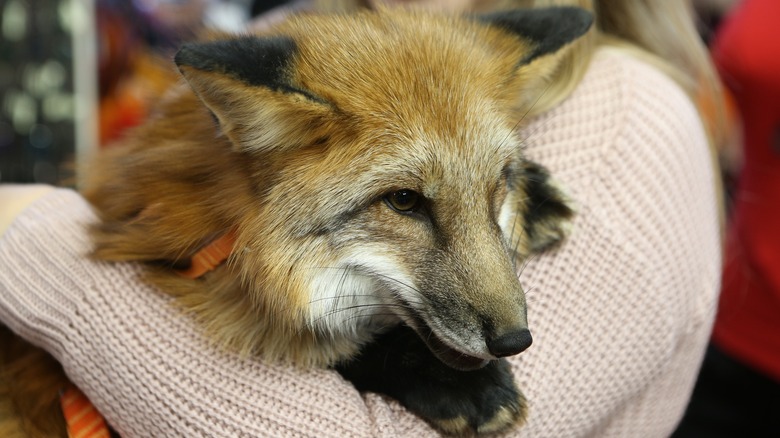The Truth About What Domestication Does To Animals
Dogs are great, right? So willing to please (unless they're not), so happy-go-lucky (unless they're not), and so cute (as puppies, anyway). We have some intrepid wolves and daring campfire humans to thank for the unique relationship we share with our closest inter-species buddies. We know that dogs split off from wolves some 27,000-40,000 years ago, per New Scientist, and we have evidence of the first dog burial as far back as 12,200 BCE. That's right around the time humans started domesticating plants and becoming farmers rather than foragers. This makes dogs our oldest domesticated animal.
And now? We've had plenty of time to breed dogs into every shape and size, from Chihuahua to Newfoundland, shaggy to shorthair, brindle to black. Yet, they're all the same species. They all share the same docile, eager-to-please social intelligence. Sheep, pigs, cattle, horses, or llamas — domesticated in that order, from about 8000-2500 BCE (per the American Museum of Natural History) — also share similar characteristics, particularly docility. People effectively bred independence and self-sufficiency from their souls.
But why, biologically, are domesticated animals so docile? It's because their brains are smaller. As 2021 research posted on the Royal Publishing Society website reveals, tamer cows have smaller brains. As Popular Mechanics cites, domesticated pigs have brains 35% smaller than wild boars, and housecats 30% smaller than their wild counterparts. This is part of a well-known phenomenon dubbed "domestication syndrome," a suite of effects that happens to all domesticated animals.
Small brain, tame personality
It's easy to make the obvious "tiny brain, giant heart" joke when talking about gentle, domesticated animals. After all, we all quietly know that no matter how smart an animal like a dog is, they're also lovably stupid. They're like dependent children whose minds have atrophied from a lack of hardship. As it turns out, research validates this intuitive sense.
The real question about domestication syndrome relates to causality and brain anatomy. Our ancestors observed which animals were more docile, more easily controlled, and bred them generation after generation, as National Geographic says of horses around 3000 BCE. Animals with easier dispositions were more likely to pass on their genes. But does this mean that a smaller brain yielded an easier disposition? Or that an easier disposition resulted in a smaller brain during development because of how an animal interacted with its environment and solved problems? And we're talking about ratios, by the way, relative to body size.
The real answer is more complex. As Popular Mechanics says, domesticated animal brains shrunk in particular regions — specifically, the parts of the brain involved in monitoring for environmental danger. Their "flight or fight" response is subdued, which means they react less aggressively to potential threats and don't mind rolling over and doing tricks for food. One 2017 paper on Nature describes this effect in chickens appearing after only five generations.
Floppy ears, short snouts, and spotted coats
Have you ever noticed how wild hares have those enormous, springy ears constantly surveying their environment? Well, Fluffy the floppy-earned bunny at home practically steps on himself. Or how coyotes have those long, nearly pointed snouts for sniffing around? Charlie the pug looks like a compressed accordion.
These types of morphological changes (changes to physical appearance) all happen — 100% across the board — to domesticated animals. As Aeon relates, goats, sheep, cows, pigs, dogs, and rabbits all have floppier ears, shorter snouts, lighter fur, and spotted or mottled color patterns. (Dogs like triangle-eared German shepherds are the exception because they've been bred for a certain type of work.) It makes sense that domesticated animals need ears less acute at detecting sound, and noses less adept at smelling for food or foes. But why in the world would they develop patchwork, multicolor fur?
A 2014 study published in the journal "Genetics" on Research Gate posits what it calls a "unified explanation." There's a specific set of cells called "neural crest cells" that influence the development of every single domesticated animal feature, including tameness. During development in utero, neural crest cells travel to ears to form cartilage, the skin to create color, and the nose to promote length. They even settle under the kidneys to induce the production of adrenaline, which fuels the aforementioned "fight or flight" response. Fewer neural crest cells transform a prowling wolf into a puffy lapdog.
The forgotten Russian domesticated fox experiment
Lots of folks might wish for a pet fox. After all, they make lots of cute squeaking sounds and are kind of like dog-cats, or cat-dogs, or something, right? Well, not quite. As fox owner David Basset said to Verge Science on YouTube, domesticating a fox doesn't make it a dog. It makes it a domesticated fox. But yes, they're okay with leashes.
David and his wife Amy are the owners of foxes bred in a fast-forward domestication experiment that started in 1960 in Russia, when the Russian Academy of Sciences' Institute of Cytology and Genetics in Novosibirsk wanted to tinker with silver foxes. As Science News says, geneticist Dmitry Belyaev took 130 silver foxes and started breeding them for tameness. By 1979, per the Washington Post, Belyaev was already noticing physical changes: splotchy fur, curled tails, stubby ears, that sort of thing. The foxes also started wagging their tails. And now? Six decades later the offspring of that experiment can be purchased for about $9,000 each.
Some have criticized the experiments' results, saying that the foxes were tamer than most animals to begin with, or that the population was too small to properly illustrate domestication syndrome. But then again, wouldn't every domesticated animal have been somehow predisposed to adjusting to life with people? There's a reason people didn't domesticate badgers or lemurs.
Whether foxes or cows, one thing's for sure: Our small-brained friends of house and farm really can't do without us.



